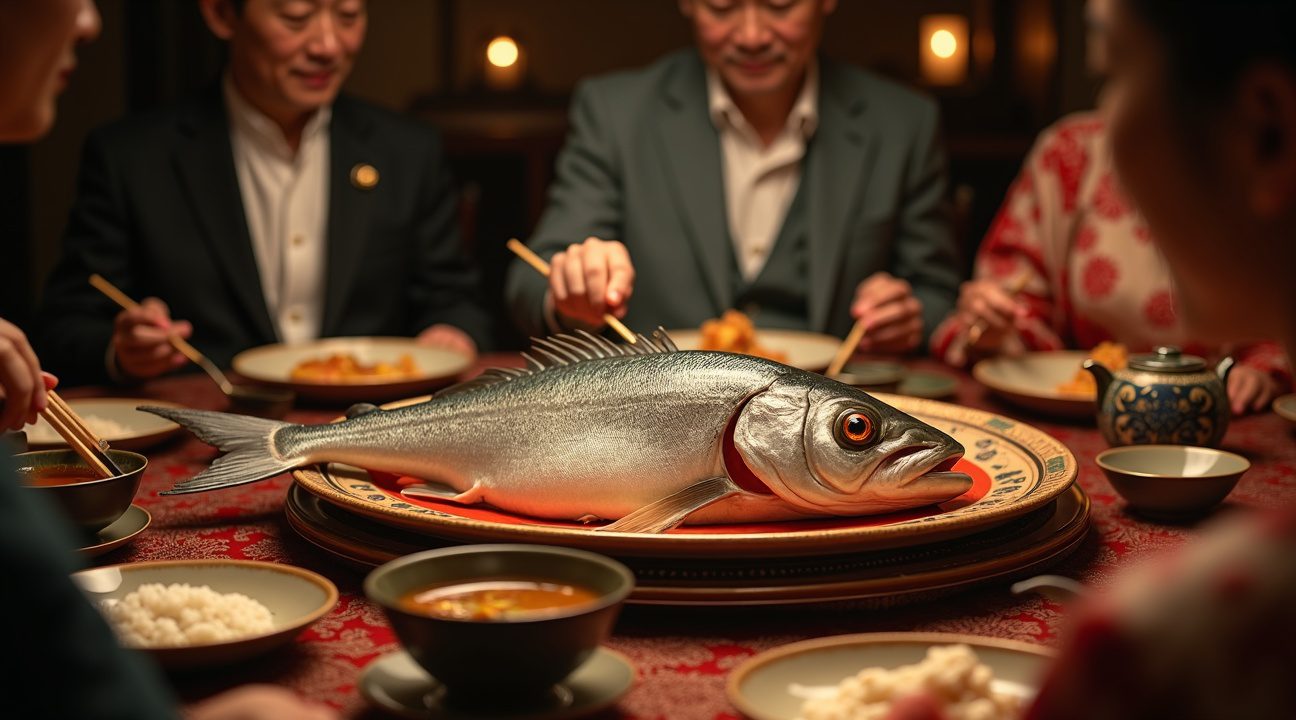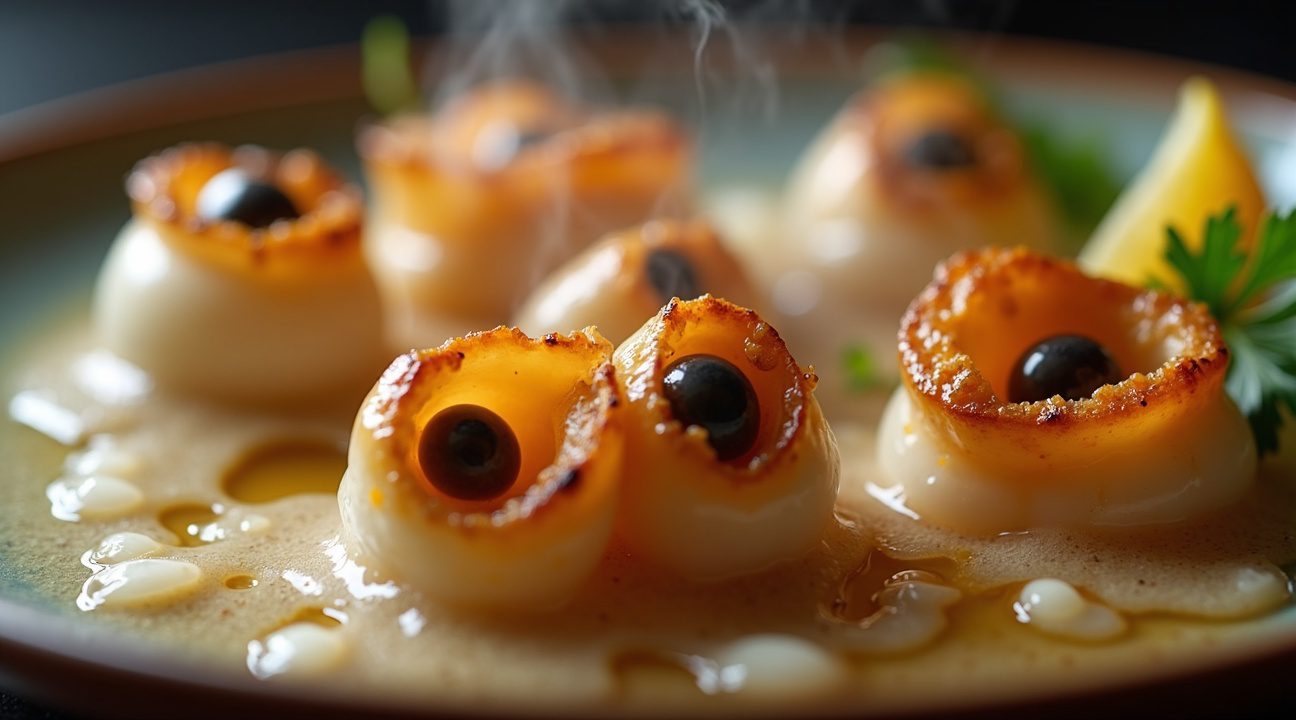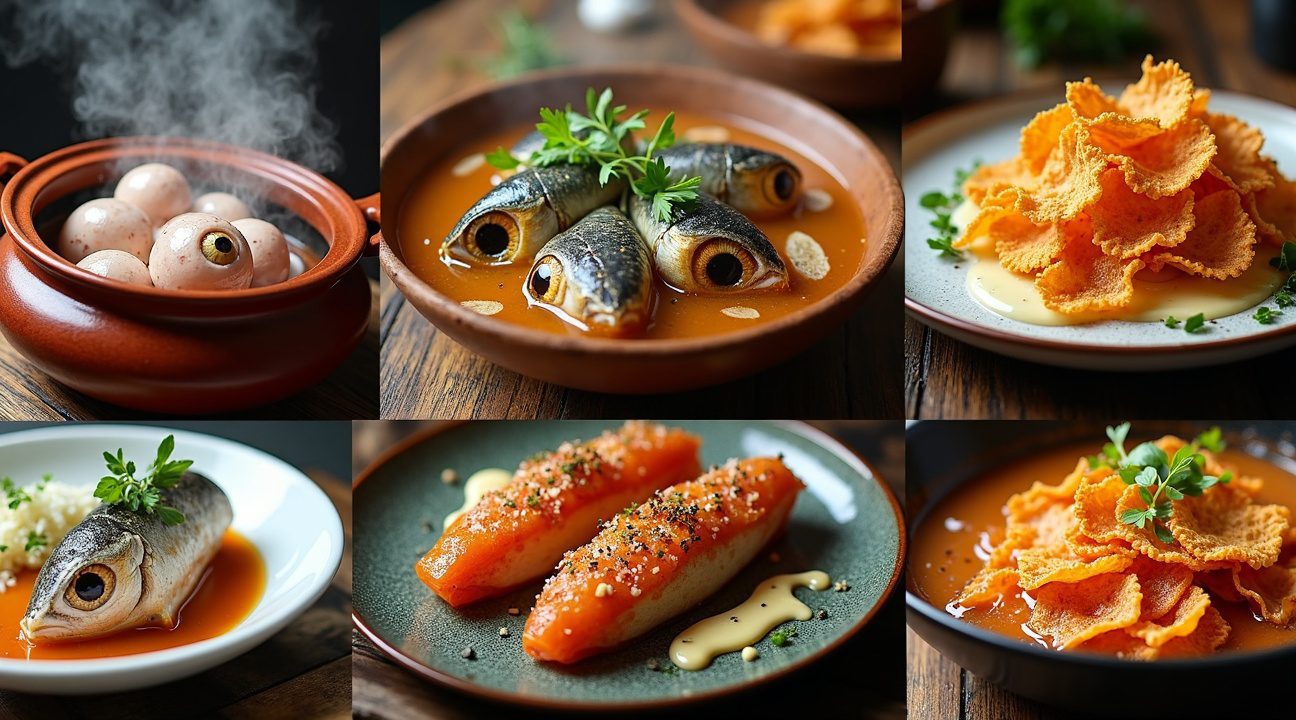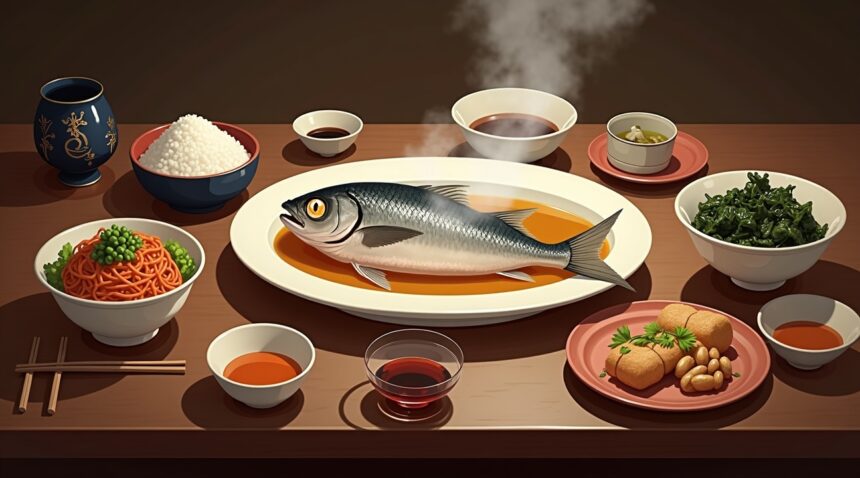Fish eyes represent a fascinating intersection of culinary tradition, nutritional science, and cultural significance that extends far beyond their unusual appearance.
While Asian cultures have long celebrated these gelatinous spheres as prized delicacies rich in omega-3 fatty acids, vitamins, and collagen, Western attitudes are gradually shifting as sustainability movements and adventurous dining trends introduce this nutrient-dense ingredient to new audiences worldwide.
Key Takeaways
- Fish eyes are considered delicacies in Asian cultures and are traditionally offered to honored guests, representing respect for whole-animal consumption and maximizing nutritional value from every part of the fish.
- They contain concentrated levels of omega-3 fatty acids, vitamins A and D, collagen, and hyaluronic acid, making them nutritionally valuable for heart health, vision, skin elasticity, and joint function.
- The taste is described as rich, umami, and slightly fatty with a unique texture featuring a gelatinous outer layer and crunchy core, often compared to fish-flavored grapes or raw oysters.
- Popular preparations include Japanese tuna eye dishes simmered in dashi, Russian Ukha soup, Spanish sauces using eyes as thickening agents, and modern innovations like fish eye chips.
- Safe preparation for beginners involves blanching to remove impurities, gentle simmering with flavorful ingredients like soy sauce and ginger, and sourcing from fresh, reputable suppliers while maintaining proper hygiene protocols.
Nutritional Benefits
Fish eyes deliver impressive nutritional density in their compact form. These organs concentrate essential omega-3 fatty acids, particularly DHA and EPA, which support cardiovascular health and brain function. Vitamin A content exceeds that found in most fish flesh, promoting healthy vision and immune system support.
Collagen represents another significant component, comprising the eye’s structural framework. This protein supports skin elasticity and joint health, making fish eyes attractive for those interested in natural anti-aging benefits. Hyaluronic acid, naturally present in eye tissues, contributes to moisture retention and cellular repair processes.
Professional chefs recognize fish eyes as concentrated sources of minerals including zinc, selenium, and phosphorus. These nutrients support bone health, thyroid function, and metabolic processes. The bioavailability of these compounds in eye tissue often surpasses that found in synthetic supplements.
Cultural Significance and Traditional Preparation
Asian culinary traditions have embraced fish eyes for centuries, particularly in Chinese, Japanese, and Korean cuisines. Honored guests traditionally receive the fish eye as a gesture of respect and hospitality. This practice reflects deeper cultural values around food waste reduction and whole-animal utilization.
Japanese cuisine features tuna eyes as seasonal delicacies, often prepared in specialized restaurants. Chefs simmer these large organs in dashi-based broths, creating dishes that balance umami richness with subtle oceanic flavors. The preparation requires careful timing to achieve the desired texture balance between tender outer layers and firm centers.
Chinese banquet traditions include fish eyes in whole fish presentations, where skilled diners extract them as prized morsels. Regional variations exist across different provinces, with some preferring steamed preparations while others favor braised techniques with soy sauce and aromatic spices.
Flavor Profile and Texture
Fish eyes deliver complex flavor experiences that challenge preconceptions about seafood. The taste combines rich, fatty notes with pronounced umami characteristics reminiscent of concentrated fish stock. Fresh preparations exhibit clean oceanic flavors without excessive fishiness.
Texture creates the most distinctive aspect of fish eye consumption. The outer gelatinous layer yields easily, releasing concentrated juices before giving way to a firmer, sometimes crunchy center. Experienced diners compare this sensation to biting into a fish-flavored grape or sophisticated raw oyster.
Temperature affects both flavor and texture significantly. Cold preparations emphasize the gelatinous qualities while warm dishes soften the outer layers and intensify the savory elements. Skilled preparation balances these characteristics to create harmonious eating experiences.
Modern Culinary Applications
Contemporary chefs are exploring innovative applications for fish eyes beyond traditional preparations. Molecular gastronomy techniques transform these organs into spheres, foams, and concentrated essences that capture their nutritional benefits in more familiar presentations.
Restaurant trends include fish eye chips, where dehydration creates crispy textures while concentrating flavors. These preparations appeal to adventurous diners while maintaining the nutritional integrity of the original ingredient. Specialty establishments feature tasting menus that incorporate fish eyes into multiple courses.
Home cooking applications focus on incorporating fish eyes into familiar dishes. Soup preparations allow gradual flavor integration while masking visual concerns for hesitant diners. Blending techniques create smooth sauces that deliver nutritional benefits without textural challenges.
Sourcing and Quality Considerations
Fresh fish eyes require careful sourcing from reputable suppliers who maintain proper cold chain management. Quality indicators include a clear, bright appearance without cloudiness or discoloration. Fresh specimens exhibit firm texture without mushiness or excessive odor.
Seasonal availability affects quality, with certain species offering superior eye quality during specific periods. Tuna eyes peak during winter months when fish accumulate higher fat content. Smaller fish like mackerel and sardines provide more accessible options for beginners.
Storage protocols demand immediate refrigeration and consumption within 24–48 hours of harvest. Freezing compromises texture quality, though frozen options remain viable for soup preparations where texture matters less than nutritional content.
Preparation Techniques for Beginners
- Start with blanching to remove surface impurities and any residual blood. Brief immersion in boiling water for 30–60 seconds accomplishes this while preserving texture integrity. Ice baths immediately halt cooking and maintain firmness.
- Gently simmer the eyes with aromatic ingredients like ginger, scallions, and light soy sauce. Cooking times range from 5–10 minutes depending on size, with larger tuna eyes requiring extended periods.
- Balance seasoning to enhance, not overpower, the natural umami richness. Consider additions like citrus juice or fresh herbs to brighten the dish while preserving oceanic characteristics.
Safety and Hygiene Protocols
Proper handling begins with thorough hand washing and sanitized preparation surfaces. Fish eyes require the same food safety protocols as any fresh seafood product. Cross-contamination prevention becomes especially important given their delicate nature.
Temperature control maintains quality and safety throughout preparation. Keep ingredients below 40°F until cooking begins. Cook fish eyes to internal temperatures of 145°F to eliminate potential pathogens while preserving texture.
Source verification ensures product safety and quality. Purchase from established fish markets or specialty suppliers who can provide harvest information and handling history. Avoid products of unknown origin or questionable storage conditions.
Fish eyes offer adventurous eaters an opportunity to explore sustainable dining while accessing concentrated nutrition. Proper preparation techniques and quality sourcing enable successful culinary experiences that honor traditional practices while embracing modern applications. To explore cultural dishes and creative recipes, you can visit Serious Eats or international culinary blogs for further inspiration and guidance.
Why Fish Eyes Are Considered a Delicacy in Asian Cultures
Fish eyes hold a special place in Asian culinary traditions, representing far more than just another part of the meal. In Japan, China, and Southeast Asia, these gelatinous spheres are considered prized delicacies and are typically offered to the most honored guests at the table. This practice stems from centuries-old cultural beliefs that emphasize respect for the entire animal and recognition of the eye’s unique nutritional value.
The tradition reflects a fundamental philosophy of whole-animal consumption that runs deep in Asian food culture. Rather than discarding any part of the fish, cooks incorporate every element to maximize both nutrition and flavor.
Fish eyes contain high concentrations of omega-3 fatty acids, vitamins A and D, and collagen, making them particularly valuable from a health perspective. This nutritional density has contributed to their status as a special treat worthy of presentation to esteemed guests.
Cultural Significance and Modern Perceptions
Western attitudes toward fish eyes have historically differed dramatically from Asian perspectives. Most Western cultures have traditionally viewed fish eyes as waste products to be discarded during food preparation. This cultural divide highlights how different societies approach food sustainability and animal utilization. However, recent years have brought notable shifts in Western culinary attitudes as global food trends and increased interest in international cuisines have sparked curiosity about previously unfamiliar ingredients.
Professional chefs and adventurous home cooks are beginning to explore the potential of fish eyes, driven by movements focused on nose-to-tail eating and reducing food waste. Researchers find that this growing acceptance reflects broader changes in how people think about sustainable food practices and cultural exchange through cuisine.
Sri Lanka offers another compelling example of fish eye consumption that emphasizes practical resourcefulness. The widespread tradition of consuming entire fish, including the eyes, demonstrates a cultural approach that prioritizes making the most of available nutritional sources. This practice reflects both economic sensibility and deep respect for the food being consumed.
The preparation methods for fish eyes vary significantly across different Asian cultures:
- Japanese cuisine often incorporates fish eyes into traditional soups and stews, where they add both flavor and visual impact.
- Chinese cooking frequently includes fish eyes in whole fish presentations, particularly during celebratory meals where the complete fish symbolizes abundance and prosperity.
- Southeast Asian preparations might feature fish eyes in curries or grilled preparations that highlight their unique texture and taste.
I’ve observed that the gelatinous texture of fish eyes can be challenging for newcomers, but many people find the experience rewarding once they adjust to the unfamiliar sensation. The flavor is typically mild and slightly sweet, with a richness that comes from the high fat content. Professional chefs often describe the taste as oceanic and clean, without any fishiness that might concern first-time consumers.
Modern food scientists have validated many of the traditional beliefs about fish eyes’ nutritional benefits. The high concentration of DHA and EPA omega-3 fatty acids supports brain and heart health, while the vitamin A content promotes good vision. These findings have helped bridge the gap between traditional knowledge and contemporary nutritional understanding.
The presentation of fish eyes at formal meals carries deep symbolic meaning in many Asian cultures. Offering the fish eye to a guest represents genuine respect and honor, demonstrating the host’s desire to share something precious and beneficial. This gesture transcends mere food sharing and enters the sphere of cultural communication and relationship building.
As global cuisine continues to evolve and cross-cultural exchange becomes more common, fish eyes are gradually gaining acceptance in previously resistant markets. Food enthusiasts and sustainability advocates are leading this charge, promoting the idea that complete animal utilization represents both environmental responsibility and culinary adventure. The growing popularity of authentic Asian restaurants has also contributed to increased exposure and acceptance of fish eyes among Western diners.

The Surprising Nutritional Benefits Hidden in Fish Eyes
Fish eyes contain an impressive array of nutrients that make them a powerhouse addition to any health-conscious diet. These often-discarded parts of the fish harbor concentrated levels of essential compounds that can significantly benefit overall wellness.
Essential Fatty Acids and Vitamins
The omega-3 fatty acid content in fish eyes stands out as one of their most valuable nutritional components. These beneficial fats play a crucial role in supporting cardiovascular health by helping to reduce inflammation and promote healthy blood flow. Unlike many other food sources, fish eyes deliver these omega-3s in a highly concentrated form.
Vitamin A represents another key nutrient found abundantly in fish eyes. This essential vitamin contributes to bone strength development and maintenance, while also supporting optimal eye health. The vitamin A content specifically helps prevent night blindness, making fish eyes particularly beneficial for maintaining clear vision in low-light conditions.
Protein and Specialized Compounds
Fish eyes serve as an excellent protein source, providing the body with essential amino acids needed for muscle development and tissue repair. This protein content makes them a valuable addition for those looking to increase their daily protein intake through unconventional sources.
The presence of hyaluronic acid sets fish eyes apart from many other foods. This specialized compound offers significant benefits for both skin health and joint lubrication. Hyaluronic acid helps maintain skin moisture and elasticity while supporting joint function by keeping cartilage well-lubricated and flexible.
The composition of fish eyes reveals their unique nutritional makeup – they consist of approximately 99% water and around 1% hyaluronic acid. This high water content doesn’t diminish their nutritional value; instead, it makes the concentrated nutrients more bioavailable to the body. The small percentage of hyaluronic acid becomes particularly significant when considering how expensive this compound can be in supplement form.
For those interested in exploring unusual marine delicacies, giant squid discoveries have opened new conversations about unconventional seafood options. Similarly, research into deep-sea fish species continues to reveal new nutritional possibilities from ocean depths.
I find that incorporating fish eyes into one’s diet requires an open mind, but the nutritional benefits make the effort worthwhile. The concentrated omega-3 content alone provides substantial health advantages that many people struggle to obtain through conventional dietary sources. When prepared properly, these nutrient-dense organs can complement a balanced diet while providing unique compounds that support multiple aspects of health.
The protein quality in fish eyes matches that found in fish muscle tissue, making them an efficient way to maximize nutritional value from the entire fish. This approach aligns with sustainable eating practices while delivering exceptional health benefits through nutrients that might otherwise go to waste.
https://www.youtube.com/watch?v=1k1Jg6uBzTQ

What Fish Eyes Actually Taste Like and Their Unique Texture
I find that fish eyes deliver a surprisingly complex flavor profile that catches many first-time tasters off guard. The taste is rich and deeply umami, with a slightly fatty quality that lingers on the palate. This intense savory character comes from the high concentration of proteins and natural fats within the eye structure.
Texture Variations Create a Unique Eating Experience
The texture of fish eyes presents multiple sensations in a single bite. The outer layer, known as the sclera, offers a gelatinous and rubbery consistency that yields under gentle pressure. As you bite through this outer membrane, the core reveals an unexpectedly crunchy element that provides textural contrast. Many people describe this experience as similar to eating raw oysters, while others playfully compare it to biting into “fish-flavored grapes.”
The species of fish significantly impacts both taste and texture characteristics:
- Saltwater fish eyes tend to have a more pronounced briny flavor.
- Freshwater fish eyes often present a milder, cleaner taste.
- Larger species usually offer more substantial eyes with more noticeable textural differences.
Cooking methods play a crucial role in developing the final flavor profile:
- Boiling softens the gelatinous qualities while preserving core firmness.
- Grilling adds a subtle smoky note that enhances the umami flavors.
- Broiling creates a caramelized exterior, intensifying the taste.
I’ve noticed that preparation techniques can make or break the experience for newcomers. When properly prepared, fish eyes become an interesting delicacy rather than an intimidating challenge. The key lies in understanding how different cooking approaches affect the delicate balance between the various textural elements.
Temperature also influences the eating experience significantly. Warm fish eyes tend to release their flavors more readily, while cooled versions can feel more gelatinous and may be less appealing to sensitive palates. Deep-sea varieties often have particularly interesting characteristics due to their unique living conditions.
For those curious about trying this delicacy, I recommend starting with smaller fish eyes from mild-flavored species. This approach allows you to appreciate the unique textural qualities without being overwhelmed by intense flavors. The experience varies considerably based on personal taste preferences and cultural background, making fish eyes a truly individualized culinary adventure.

Popular Fish Eye Dishes from Around the World
Fish eyes appear in culinary traditions across multiple continents, showcasing the ingredient’s remarkable versatility. I’ve discovered that these delicate morsels can be prepared through various cooking methods, each designed to enhance their unique texture while minimizing any overwhelming oceanic flavors.
Traditional Preparation Methods
Cooks employ several techniques to make fish eyes more palatable for diverse audiences. Raw consumption offers the most authentic experience, while grilling, baking, and broiling provide different textural outcomes. Incorporating them into soups and stews allows the eyes to absorb surrounding flavors while contributing their own distinctive character to the dish.
Notable International Dishes
Russia’s traditional Ukha soup represents one of the most celebrated fish eye preparations, with origins stretching back to the 17th century. This hearty soup incorporates entire fish heads, including the eyes, creating a rich broth that exemplifies the country’s resourceful cooking traditions.
Japanese cuisine elevates tuna eyes through a sophisticated simmering process. Chefs combine dashi, soy sauce, mirin, sake, and ginger to create a complex flavor profile. This preparation yields a fascinating contrast between the chewy outer membrane and the soft, gelatinous center that researchers find contains valuable nutrients.
Fish Eye Chips offer a contemporary twist on this ancient ingredient. These crispy preparations transform the eyes into crunchy snacks or elegant garnishes that add both visual appeal and textural interest to various dishes. The dehydration process concentrates flavors while creating an entirely different eating experience.
Spanish culinary traditions utilize fish eyes for their natural thickening properties in sauces. This practical application demonstrates how different cultures recognize the functional benefits beyond mere sustenance. The eyes contribute body and richness to gravies and reductions without requiring additional thickening agents.
Each preparation method reveals how global cuisines have adapted this ingredient to local tastes and cooking traditions. The transformation from what many consider an unusual ingredient into these refined dishes shows the creativity and resourcefulness found in traditional cooking practices worldwide.

How to Safely Prepare Fish Eyes for First-Time Eaters
Preparing fish eyes properly makes all the difference for newcomers to this unique delicacy. I always recommend starting with blanching, which removes impurities and significantly reduces any strong odors that might put off first-time eaters. Simply drop the eyes into boiling water for 30-60 seconds, then immediately transfer them to an ice bath to stop the cooking process.
Essential Cooking Techniques
Simmering represents the most approachable method for beginners. I create a flavorful base using dashi, soy sauce, sake, mirin, and fresh ginger – these ingredients work together to enhance the natural taste while masking any overwhelming flavors. The combination creates a balanced umami profile that complements rather than fights the eye’s natural characteristics.
An otoshibuta proves invaluable during this process. This traditional Japanese drop lid sits directly on the surface of the simmering liquid, ensuring even heat distribution and continuous basting. The result is consistent texture throughout and prevents the delicate eye membrane from becoming tough or rubbery. Without this tool, aluminum foil with small holes punched through makes an adequate substitute.
Temperature control matters significantly. I maintain a gentle simmer rather than a rolling boil, which can cause the eyes to burst or become overly firm. The cooking time typically ranges from 8-12 minutes, depending on the size of the eyes.
Safety and Sourcing Guidelines
First-time consumers should always choose cooked preparation over raw consumption. Cooking softens the unique texture that many find challenging initially, while heat treatment eliminates potential pathogens. The deepest fish species often have different textures, but standard preparation methods work across most varieties.
Source selection requires careful attention. I only use eyes from fresh, food-grade fish obtained from reputable suppliers. The eyes should appear clear with no cloudiness or unusual discoloration. Any fishy smell beyond the normal oceanic scent indicates spoilage.
Hygiene protocols remain non-negotiable throughout preparation. I wash hands thoroughly before and after handling, use separate cutting boards for fish products, and ensure all utensils are properly sanitized. Cross-contamination poses real risks, particularly when working with organ meats like eyes.
Storage timing affects both safety and quality. Fresh fish eyes should be prepared within 24 hours of the fish’s harvest when possible. If using frozen eyes, thaw them slowly in the refrigerator rather than at room temperature to prevent bacterial growth.
The final texture should feel tender when pierced with a fork, similar to a soft-boiled egg yolk. Properly prepared fish eyes offer a creamy interior with a slightly firmer outer membrane, creating an interesting contrast that even skeptical eaters often find surprisingly pleasant.

Fish Eye Traditions Across Different Cultures
Fish eye consumption practices differ dramatically around the globe, with each culture bringing its own preparation methods and cultural significance to this distinctive food source. I’ve observed fascinating variations in how different societies approach this protein-rich delicacy, from revered traditional preparations to modern culinary innovations.
Traditional Preparation Methods and Cultural Significance
Japanese cuisine elevates tuna eyes to an art form through their preparation of Maguro no Medama. Chefs carefully simmer these substantial organs in dashi with soy sauce, mirin, and sake, creating a dish that commands respect and appreciation. The preparation reflects Japan’s deep connection to seafood traditions and the philosophy of using every part of the fish.
Russian culinary traditions incorporate fish eyes naturally into Ukha, a traditional fish soup that embraces the whole fish experience. Cooks prepare this hearty soup with the fish head and eyes intact, allowing the gelatinous properties to enhance the broth’s richness. This approach demonstrates the practical wisdom of maximizing nutritional value from every component.
Spanish kitchens utilize fish eyes as natural thickening agents in stews and sauces, showcasing their functional versatility beyond simple consumption. This technique adds body and texture to dishes while ensuring nothing goes to waste. The eyes contribute both nutritional value and improved consistency to traditional recipes.
Sri Lankan households frequently include fish eyes in their daily meals by boiling the entire fish and consuming every edible portion. This practice reflects both cultural tradition and practical necessity, ensuring maximum nutrition from available protein sources. The approach demonstrates how deep fish consumption practices can be both sustainable and culturally meaningful.
Western culinary landscapes present a contrasting picture, where fish eyes have historically faced resistance due to cultural taboos and unfamiliarity. However, experimental chefs and high-end restaurants are challenging these perceptions by introducing creative preparations that showcase the delicacy’s potential. These culinary pioneers grill or broil fish eyes to create approachable entry points for adventurous diners.
The growing interest in nose-to-tail eating philosophies has sparked curiosity about previously overlooked ingredients like fish eyes.
- Progressive restaurants now feature them as specialty items.
- Many chefs educate diners about their nutritional benefits.
- This shift represents a broader movement toward reducing food waste.
Cultural attitudes toward fish eye consumption often reflect broader relationships with food sustainability and traditional knowledge systems. Societies with long-standing fishing traditions typically view eye consumption as natural and beneficial, while cultures with different protein sources may need time to adapt to these practices.
The texture and flavor profiles of properly prepared fish eyes can surprise newcomers to this delicacy. When cooked correctly, they offer a tender, gelatinous consistency that readily absorbs surrounding flavors. Their mild taste makes them adaptable to various seasoning approaches and cooking methods.
Modern food movements emphasizing zero-waste cooking have brought renewed attention to fish eye preparations across different cultural contexts. Chefs worldwide now study traditional methods from various cultures to develop contemporary applications that honor both heritage and innovation. This cross-cultural exchange enriches global understanding of sustainable seafood consumption practices.
The nutritional density of fish eyes makes them valuable additions to diets regardless of cultural background.
- High collagen content for skin and joint health
- Rich in omega-3 fatty acids supporting heart and brain function
- Contains vitamin A crucial for vision and immunity
Understanding different cultural approaches helps identify the most appealing preparation methods for individual preferences.

Sources:
Chowhound – Yes, You Can Eat Fish Eyes — Here’s How to Cook Them
The Japanese Food Lab – Simmered Tuna Eye
Outdoor Geeky – Can You Eat Fish Eye?
Chef Epic – Eating Fish Eyeballs
eGullet Forums – Fish Eyes Cooking
Fine Dining Lovers – Fish Eyes: How to Use Them


